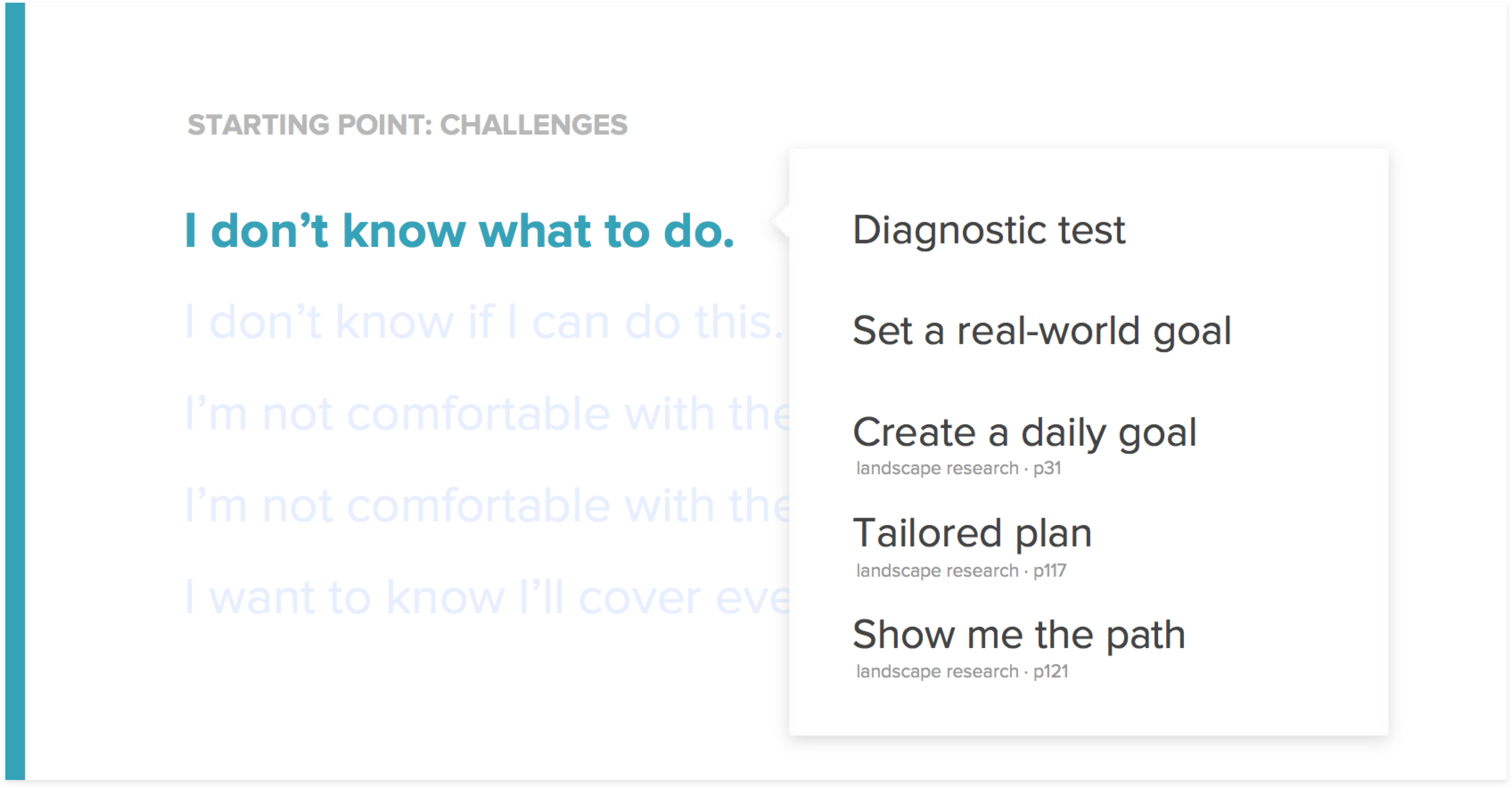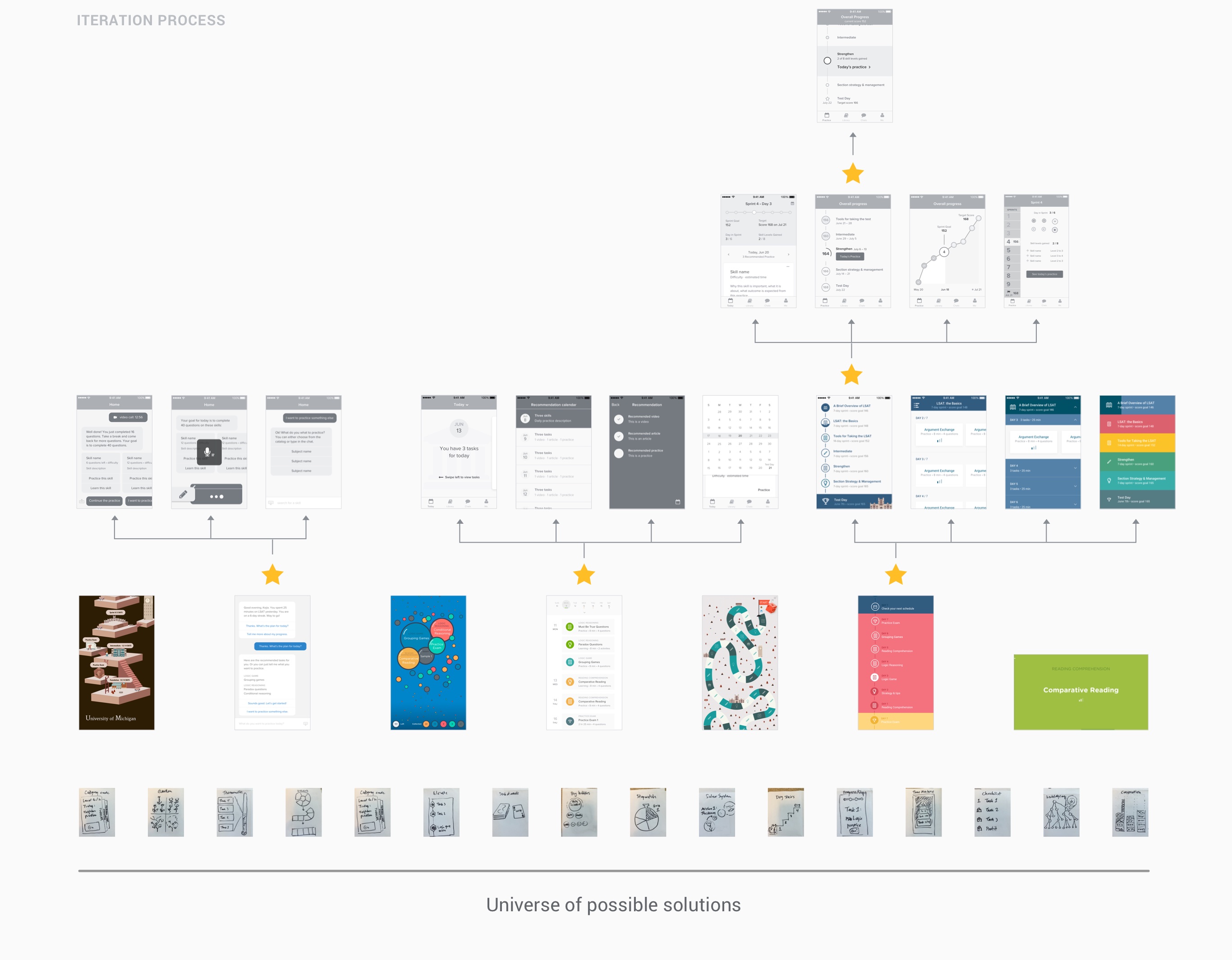Khan Academy mobile product

Why test prep?
Khan Academy is doing test prep because:
It aligns with our mission.
- A test prep product will make it possible for students to remove the exam as a barrier to achieving their academic and professional goals.
- By making free test prep, we can make the field a fair playground, where everyone has equal access to the contents and practices.
It helps with growth and business sustainability.
- With test prep, KA is able to directly reach students. Over 2 million students take SAT each year, and many other tests have more takers.
- CollegeBoard sponsors KA to produce free SAT prep, and we hope to replicate this business model with other test makers.
It is a market with room for exploration.
- There’s no killer online platform for test prep. Most test prep is done offline by tutors and classes.

Research
Interview and personas
There is a wide variety in the world of tests: different formats, users, motivations, time investment, coaching, and strategies. At the beginning of the initiative, we had a lot of knowledge about SAT, but we didn’t have too much info for the other tests we may consider. Therefore, we started by researching into a variety of tests. Once we got a hold of the test realm, we started talking with ~20 test takers to understand their motivations, test prep journey, and pain points.

During the interviews, we identified 3 dimensions that are influencers on the amount of effort and the emotions test takers go through: confidence gap, time pressure, and the importance of the test. Our test prep product would only address the cases where the perceived importance of test is high. Depending on confidence gap and time pressure, 4 personas emerge: the verifiers, the preparers, the procrastinators, and the ready.

We decided to focus the product on the preparers, because they are the people we can help the most with; they have the longest prep journey and biggest need for plan and improvement. We saw this pattern in SAT takers as well: a very small amount of people contribute to more than half of the usage.
I don’t know (whether my schedule will work out), fingers crossed, it’s a puzzle.
Angela, LSAT taker
The preparers' journey
To support students like Angela, We mapped out the preparers’ journey, including their emotional state, social support, content focus and key needs, and used our findings as the starting point of the design.

Storyboarding
With the brainstorm ideas and interview synthesis, we wrote user story to envision how the product will help the students: e.g. students touchpoint, the context of use, types of practice, expected practice outcome, etc.. This also helped us as a team to align our direction.
Design principles
Another deliverable of research was a set of design principles for us to use as a reference when facing design choices. One thing I learnt (from Intercom) is to make sure the design principles are opinionated. We used to have principles like “address students’ emotional needs”, which was vague and more like a mere truism, making it not super helpful in guiding our design. We elaborated it and added “provide tough love as needed” as we hope the product would truly motivate the students, and it’s fine if it needs to be a touch coach at times.
Landscape research
Meanwhile, I did landscape research to understand what features the existing test prep products are providing. Since a big challenge of our product would be building and keeping users’ motivation, I expanded our research pool and learned from a wide range of domains, including language learning, fitness, weight loss, personal finance, habit forming, scheduling, etc., basically anything that might have a starting point, an ending goal, and guidance in between.

Brainstorming concepts
Two key pieces of the product are progress and recommendations. How do we keep students motivated by showing their progress? How do we tell students where they are, and how their daily tasks might contribute to the overall progress? To answer these questions, we did brainstorm together, and I developed some of the ideas in 3 days to explore their potential as well as to serve as inspiration for future exploration and other products.

Iterating and prototyping major flows
Building on top of the concepts, I iterated on the major flows of the app: progress and recommendation, architecture and navigation, onboarding, and weekly check-in. The goal of this exploration was to have a more developed flow prototype to get leadership buy-in and probe user feedback.

My role
I worked with Kitt (lead designer) and Anju (PM) on this initiative. We did research and brainstorm together, and I developed the brainstorm concepts and prototyped the major flows.
Thanks for reading!
And thus concludes my internship at Khan Academy. This product is still in initial design phase. I’m excited to see how it will evolve into a real product. Here’s my co-worker’s recommendation on my internship performance in case you’re curious.